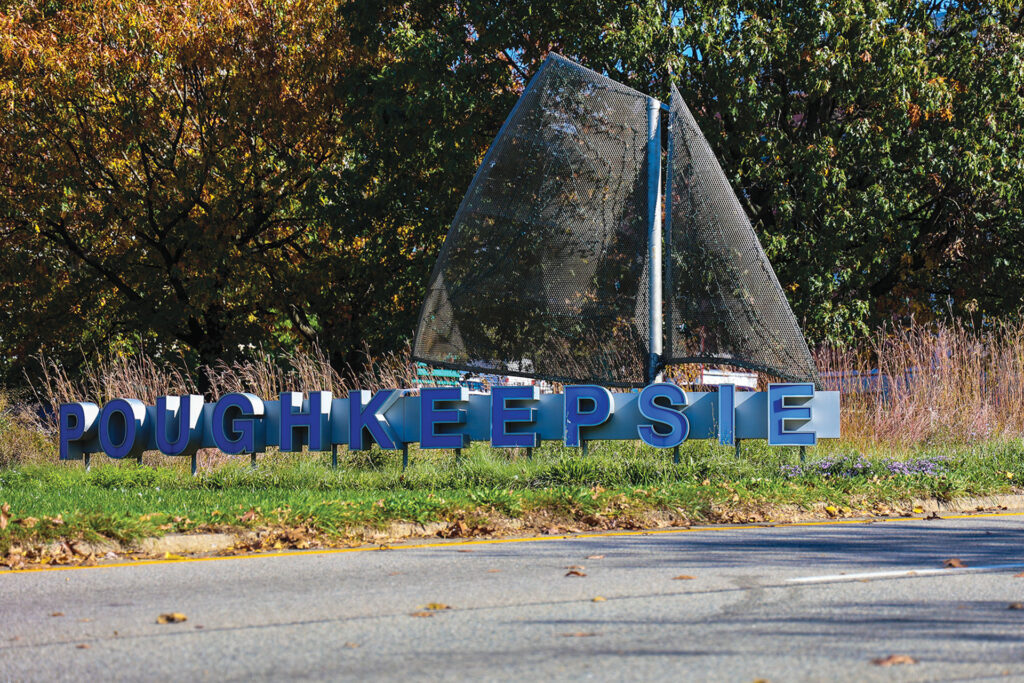If everything goes as planned, the Hudson Valley’s largest city won’t have to wait much longer.
By Simon Murray
Photography by Daniella Murray
When my fiancée needed an externship to finish her master’s in speech language pathology, we were drawn to a small town near Poughkeepsie. Born and raised in Florida, she looked to her de facto guide to the Northeast for insight. Unfortunately, I couldn’t offer much. Besides driving up I-87 to attend a college Upstate, my only exposure to the Hudson Valley came from a visit to Beacon. Far from the tourist destination it is today, back then, gentrification’s creep from New York City had yet to claim its first footholds along the Metro-North railway. Beacon, warts and all, still retained a diverse population of residents, including good friends of mine, who had lived there for generations. Right now, it has more in common with Brooklyn’s Williamsburg, where a gourmet pizza will run you $30 and swanky cocktail bars refrain from printing drink prices on their menus. As a result, longtime Beaconites are being priced out.
But what of Poughkeepsie, its northern neighbor? Depending on who you ask, my fiancée and I had either missed its heyday by decades or it was a vague notion on the horizon. IBM’s colossal manufacturing presence—a 400-acre plant along the Hudson River that built everything from rifles to typewriters and computers up until the ’90s—was long gone as the most powerful force in town. Without its economic backbone, postindustrial decline had done a number to the “Queen City on the Hudson,” a lesser-known nickname for the seat of Dutchess County. It’s hard to feel regal when Main Street still bears the pockmarks of urban blight: boarded-up storefronts, abandoned homes with broken windows and overgrown grass, empty lots, buildings in disrepair.
A few years before we settled here in 2022, the decay became all but impossible to ignore. A powerful windstorm knocked the roof off a seven-story high-rise between Main Street and Cannon Street in the downtown corridor. Seemingly overnight, the city skyline had lost one of its tallest buildings. The effect wasn’t unlike being forced to fly a flag at half-mast.
“I think that’s really the case,” says Evan Menist, Poughkeepsie Second Ward Councilmember. “Which is why it’s critical to get rid of underutilized space and maximize its use for a more efficient and productive city center.” To atone for the sins of long-since-failed urban renewal plans implemented in the late 20th century, city leaders like Menist are rezoning neighborhoods to boost population density and dangling tax breaks for developers. Encouragingly, the early signs show promise, though it’s hard to blame incredulous residents who’ve seen their fair share of false starts.
Progress, while slow, is appearing in pockets. Apartment buildings and brick-and-mortar businesses have started to pop up here and there. But the most surprising development is IBM expanding its manufacturing footprint, with roughly 3,000 workers at its Poughkeepsie campus building mainframes and computer chips. With the help of a world-class oncology department at Vassar Brothers Medical Center (Dyson Center) and two highly rated liberal arts schools in Marist and Vassar College, this surging town has a lot to offer professionals of all ages.
Tired of watching other towns around them find their way, the people of Poughkeepsie are ready for a rebound. There’s a vibrant energy here, not to mention a lot of pride as a municipality filled with familiar, neighborly faces. But don’t let its small-town charm fool you. At twice the size of Kingston and Beacon and slightly larger than Newburgh, Poughkeepsie is a regional economic powerhouse. It also doesn’t hurt that it’s the geographic heart of the Hudson Valley and the last stop on the Metro-North’s Hudson Line. You can see its potential when walking down buzzy Academy Street, with its assortment of neighborhood bars, bakeries, pizza parlors and barbecue joints. It’s at these watering holes where locals rub shoulders with visitors, and where the idea of revitalization without gentrification is taking root.
“From an outsider’s perspective, they might look at the city and think revitalization here is happening slower or it’s not really taking off,” says Menist, who has a background as an urban planner with the nonprofit Hudson Valley Pattern for Progress. “But I would say that’s a very uninformed view. We’ve worked hard to ensure the policies we’ve put in place allow development without displacement, so at the end of the day, we don’t have a brand-new city with brand-new people.”
Downtown revitalization always starts someplace exactly like 40 Cannon, a mixed-use retail and residential building a block away from Main Street. When developers Jim and Gina Sullivan purchased the property from its previous owner in 2013, the brick building had been sitting vacant for a couple years after being gutted by fire. The scope of the project rivaled anything the husband-and-wife duo had previously undertaken. Jim, a licensed plumber and electrician, was used to building things with his hands, so he took a calculated risk. Before breaking ground, they reached out to workforce development programs in the area to employ about 60 local workers.
These able bodied individuals came from all different kinds of backgrounds. Some had zero construction experience and came right out of jail or rehab. “And we put them through this program where they’d work with journeymen as apprentices,” says Jim. Upskilling these workers took time, delaying the project by about eight months. But the results were worth it. While a few didn’t stick around to see it through completion, “others went on to hold steady jobs in the trades that they learned, which was really rewarding.”
Today, the 49-unit apartment building on the site of the iconic Kings Court Hotel encompasses a brewery, a café, a standalone art gallery and ten dedicated affordable units for lower-income workers. And it’s far from a one-off idea. The Sullivans are onto their fourth residential development on Cannon Street alone. “I can’t say we had plans to buy the block, but it kind of happened like that,” adds Jim.
Developers like the Sullivans are starting to put a dent in the 537 vacant or abandoned buildings around Poughkeepsie, and businessowners are taking notice. “Within two to five years you won’t recognize this city based on the plans that I’ve seen,” says Jillian Grano, owner and co-founder of Canvas + Clothier. Marooned on a side street, this “micro-department store” encompasses two floors (and even boasts a café). It was important for the owners to focus on American-made home goods, accessories and clothing that’s practical and fashionable. While most of their sales are generated online, Grano’s hopeful the bet they’ve made on a physical location in Poughkeepsie will pay off.
For that to happen, more shops and boutiques will need to move into the area. If they do, it might resemble a modern version of the Poughkeepsie Main Mall, a failed urban renewal project that was supposed to save the historic business district in the ’70s. Instead, thanks to other unfortunate policies at the time, it only hastened its demise. It’s hard to believe when walking downtown, but the Main Mall was an outdoor shopping plaza connected by a pedestrian thoroughfare with rows of boutiques on either side. It looked practically European.
Foot traffic in Poughkeepsie’s a far cry from those days, though you’re starting to see an uptick. The issue remains how fractured the city’s become. The Walkway Over the Hudson—a former railroad bridge turned resplendent bike trail offering unrivaled views of the surrounding area—is a big draw for locals and tourists alike. And yet it’s isolated, with only a few storefronts nearby to take advantage of the steady influx of bikers, joggers and people out enjoying a stroll. The inverse holds true for the Hudson River waterfront, an outrageously underutilized district that’s never gotten much traction.
Plagued by questionable policies of years past, the most disastrous continues to be the “Arterial,” a three-lane, one-way highway that pinches off and restricts large parts of downtown. To alleviate traffic at any cost, it almost does its job too well: rerouting drivers to the stores and outlets along Route 9 and discouraging foot traffic in what should be a very walkable city.
“The more locals we have dining out and walking around the city, the better for everybody,” says Chef Brandon Walker, owner of Essie’s Restaurant. (It also happens to be one of the first places we ever patronized as a couple in Poughkeepsie.) Walker, a finalist on the Food Network show Chopped, is originally from Brooklyn. He became smitten with the area after graduating from the Culinary Institute of America (CIA) in the bucolic Hyde Park. “I thought New York was just the five boroughs,” he says with a smile. “I had no idea it had farms, because you just don’t see that part growing up in New York City.”
He founded Essie’s, named after his beloved grandmother, seven years ago and has witnessed a lot of change in that time—including other ambitious CIA graduates setting up their own eateries in Poughkeepsie. “These other restaurateurs are trying to provide a great service and experience and it’s important that everybody thrives,” he notes. “But in order to do that, we have to do things ethically and equitably.”
Two blocks away, the Fall Kill Creek winds through backyards and under streets before emptying out into the Hudson River. Imposing wrought-iron fences and cracked concrete walls are the canal’s only distinguishing features. So, it’s entirely predictable that people will stroll right past it along the sidewalk, never giving it a second thought. It’s an unfortunate coda for a waterway that once powered Poughkeepsie’s booming manufacturing industry. Sadly, the same could be said for the people living on the north side of the city, who are primarily Black and of lower socioeconomic status. Like the Fall Kill, their plight has been largely forgotten or ignored.
Yvonne Flowers, a 57-year-old lifelong Poughkeepsie resident—and quite recently elected mayor—knows the struggle all too well. As a child, she grew up in public housing until the age of 15, first at the Smith Street Projects and then the Dr. Martin Luther King Gardens. A graduate of the Poughkeepsie City School District and Dutchess Community College with a degree in accounting, she never saw herself becoming involved in politics. It was her late father, John M. Flowers—a local hero and Vietnam War veteran—who encouraged her to run for Fifth Ward Councilmember, a position she held for eight years.
Flowers now holds the distinction of being the first Black mayor elected in Poughkeepsie. She tells me it’s not really something she thinks about. However, she understands the excitement around having a leader who’s been in the trenches; one who doesn’t cast a blind eye to what the Black and Brown communities are going through. “In terms of revitalization, the trend is going in the right direction,” she says after I ask her thoughts on it. “But at the same time, there are investors coming into the city that are being driven by profit margins alone.” She goes on to provide two examples—one a longtime resident; another a nearly three-decade salon owner—who were displaced after developers came in, conducted sweeping renovations—and then jacked up the rents. As a homeowner and landlord herself, she’s very sensitive to their plight.
Flowers plans on fighting back against these predatory practices by imposing stabilized rents, while also developing the waterfront to boost tourism. Catering to multiple socioeconomic demographics requires a delicate balancing act. Finding the harmonious chord between enacting enough affordable housing and market-value apartments, sometimes on the same street, is unbelievably difficult. But if it pays off, it changes the future of this once-great city in search of a splashy second act.
On an unseasonably warm fall afternoon, I trade the jaw-dropping views of Zeus Brewing Company’s rooftop deck for the stylish facades of Academy Street. In tow are my sister and brother-in-law, who compare the city to Pittsfield, MA, with its postindustrial charm (the manufacturing town in the Berkshires is where they’ve just bought a home).
We stop into Hudson & Packard, the internationally award-winning Detroit-style pizza place founded by Charlie Webb, an inked-up US Army veteran and CIA graduate. The day before, his neighbor, the cocktail bar Goodnight Kenny, just celebrated their first anniversary with a block party drawing a big nocturnal crowd. A storefront over is The Academy, part-grocery, restaurant, bar, bakery, event and co-working space—with apartments up above.
It’s lunchtime, nowhere near as busy as the dinner rush, which Webb says can be “wall-to-wall.” We’re led into the basement, where Brandon Bryant, another tatted-up former service member, gives us a run-through of the baking process like a sommelier reveling in the taste of a vintage bottle of vino. “Detroit-style pizza has good crumb,” he says with an undisguisable glint in his eye. “This looks like a brick but it’s light as a feather.”
When he started working for Hudson & Packard, it’d just opened three years ago, but the footprint wasn’t big enough to sit most of their diners. When they were able to expand just a little, the business really experienced explosive growth. It’s no surprise, considering the large, long-vacant buildings being snatched up and revitalized all around them. “It was super small, and now it’s the exact opposite,” says Bryant.
Isn’t it funny how change tends to happen slowly, and then all at once? Get ready for Poughkeepsie, people! The Queen City’s gettin’ all gussied up for yet another dance.












Comments are closed.